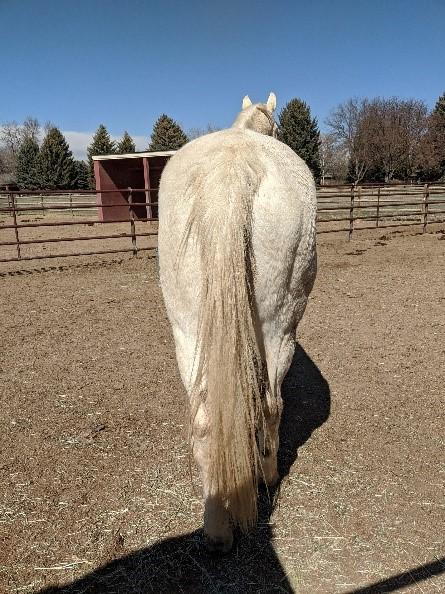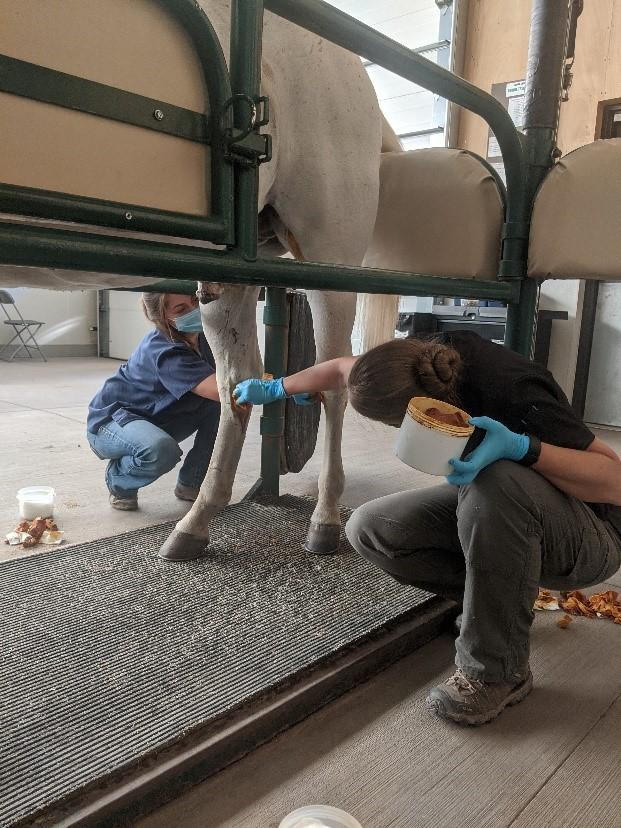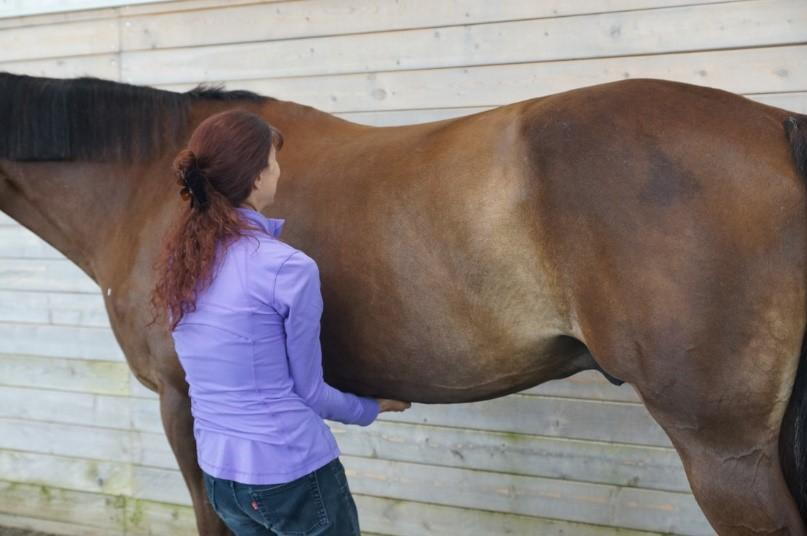Dr. Meg Bacon September 2020
Whether you are new or seasoned to the theories of rehabilitation and physical therapy, you may want more information regarding these principles for your horse. Rehabilitation is the process that assists a horse in recovering from injury, which includes physical therapy regimes to help increase strength, mobility, and fitness. Your horse does not need an injury to do rehabilitation. Equine athletes use physical therapy exercises to reduce chances for particular injury types, which means preventing injury before it occurs. So whether you want to evaluate an injury or prevent one, this article is for you!

| Pictured above: Marked left hind muscle atrophy from lack of rehabilitation after a hock surgery. |
Your veterinarian can assist you in identifying and treating areas of current pain or weakness. This all starts with a good musculoskeletal evaluation, a lameness exam, and maybe even diagnostic imaging such as radiographs or ultrasound. This process can be done all at once or broken up into separate exams. Once the problems are identified, a unique program will be made for a horse based on his or her needs.
Pharmacotherapy and needles
It is impossible to talk about rehabilitation without talking about drugs and needles. Pain control is a vital first component in the rehabilitation process, as you can only progress to increase strength, flexibility, and functionality if the pain cycle is stopped.
In the initial stages of inflammation, a combination of Non-Steroidal Anti-Inflammatory Drugs and possibly muscle relaxers may be warranted. If the injury is in or around a joint, an injection of steroids or biological anti-inflammatory agents directly to the site may be most beneficial for your horse. Biological agents such as Interleukin-1 Receptor Antagonist Protein (IRAP) or Platelet Rich Plasma (PRP) are recommended in certain types of injuries. They are also the preferred agents for any horses suffering from Equine Cushing’s or Equine Metabolic Syndrome as the use of steroids in these patients carries an increased risk of causing laminitis in those patients.

| Pictured above: Preparation for joint injections of the hock. |
Other needles may be used more specifically to change the nervous systems perception and processing of pain. Mesotherapy is used to treat at the level of the mesoderm, a layer of the skin, which has nerve fibers running through it that come from the spinal cord. This therapy involves multiple injections with a very small (27g) needles that only goes about a half a centimeter into the skin to deposit medication. This small deposition of medication disrupts and down regulates pain signaling pathways in treated areas. Acupuncture is another drug-free approach to address musculoskeletal pain in horses, among other things.
Thermal Therapy
Thermal therapy is an important component to most rehabilitation programs, especially in the early stages of an injury recovery program. Cold therapy using cold hose water, river water, ice packs, or GameReady® systems are the most beneficial in the first 24-48 hours following an injury. They are applied every two to four hours for 20-30 minutes if possible. This therapy reduces initial inflammation, swelling and pain. In certain injuries, cold therapy may be indicated for longer than 2 days. After 72 hours following an injury, we may suggest some form of heat therapy. This could be warm water from a hose (only as hot has your hand can comfortably stand), hot packs, or sweat wraps. Caution should be used when using any of these therapies, as excessively hot water or hot packs can cause thermal injury. Sweat wraps, if applied incorrectly, can cause skin irritation, or bowed tendons. These therapies are usually suggested at least once a day for 20-30 minutes prior to rehabilitation exercises. The heat will enhance tissue stretching, reduce any muscle spasms, and increase the healing response of the body. It should also be noted that warming up your horse prior to exercise is just as important for them as it is for you before a work-out, so do not forget to dedicate some time at the beginning of your ride for that purpose!
Manipulative Therapies

| Pictured above. Proper sternal lift exercise technique from Stretch Your Horse, LLC. |
There are a wide range of manipulative therapies for rehabilitation, similar to physical therapy for humans after an injury. The exercises that may be prescribed to you will depend on the type of injury, the equipment and environment available to you and your horse, and your ability to perform the exercises. Examples of manipulative therapies include passive range of motion stretches, more active stretching using rewards like carrots, and more involved isolation exercises such as sternal lifts or tail pulls.
The number of exercises is usually kept to two or three per day and will be frequently changed to become more challenging for your horse. Progression of exercises depends on how easy certain exercises become with time. If the exercises appear too difficult, or progress is not being made, then exercises will need to be adjusted.
Couch to 5K
Each horse starts from a different place in an exercise program. Whether the goal is to increase speed around the barrels, or to just go an extra couple miles on the trail, it takes conditioning. A rehabilitation program may provide you the strength and flexibility exercises, or a controlled training program, to bring you and your horse to the next level.
Controlled exercise programs cannot be emphasized enough when it comes to recovering from injuries. A soft tissue injury, such as suspensory desmitis, may take just a couple weeks or six plus months depending on severity and chronicity of the injury. It is important to work with your veterinarian to establish a schedule that will do the best for your horse at reducing injury recurrence.
It’s All About Patience
As many of you know, rehabilitation is a slow and steady kind of race and not a sprint. Time and dedication should be given to these programs, just like physical therapy exercises, as the rewards will be greatest and reinjury will become less likely in the long run. Check out our second installment on rehabilitation therapies talking about adjunctive therapies such as shockwave, laser, and kinesiology tape and how they may aid in injury recovery or providing chronic injury maintenance. We are here to support you and your horses at Alpine Equine Hospital, whether the goal is to come back from injury or prevent one.
Boldt, Jr E. Veterinary Acupuncture and Chiropracatic: What, When, Who? American Association of Equine Practitioners. 2016. Date accessed 8/27/2020. https://aaep.org/horsehealth/veterinary-acupuncture-and-chiropractic-what-when-who#:~:text=Studies%20have%20shown%20that%20acupuncture,and%20shoeing%20are%20extremely%20important.
Clayton, H. Core Training and Rehabilitation in Horses. Vet Clin Equine 32 (2016) 49-71
McGowan, C., Goff, L. Assessment and treatment of the equine thoracolumbar spine, pelvis and pelvic limb. Animal Physiotherapy: Assessment, Treatment and Rehabilitation of Animals, Second Edition (2016) 317-326.
Molle, S. Kinesio Taping Fundamentals for the Equine Athlete. Vet Clin Equine 32 (2016) 103-113
Schlachter, C. Electrophysical Therapies for the Equine Athlete. Vet Clin Equine 32 (2016) 127-147.
Image 3. Stretch Your Horse, LLC. Got a Good Topline? Why Your Horse Wants One. 3 DIY Topline Improvement Exercises and Stretches (part one of a two part series on topline.) Copyright 2017.
